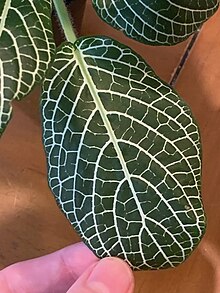Species of plant
Fittonia albivenis
is a
species
of
flowering plant
in the
family
Acanthaceae
,
native
to the rainforests of Colombia, Peru, Bolivia, Ecuador and northern Brazil. An
evergreen
perennial
, it is notable for its dark green foliage with strongly contrasting white or red veins. It is commonly called
nerve plant
or
mosaic plant
. In
temperate
regions where the temperature falls below 10 °C (50 °F) it must be grown as a
houseplant
.
[2]
Description
[
edit
]
 Inflorescence
Inflorescence
Fittonia albivenis
is a creeping evergreen perennial growing to 15 cm (6 in) high, with lush green,
ovate
leaves, 7 to 10 cm long, with accented veins of white to deep pink and a short fuzz covering its stems. Small buds may appear after time where the stem splits into leaves. There are also forms in which the nervatura is carmine-red. Flowers are small with a white to off-white color.
[3]
 Leaf detail, showing the prominent white veins
Leaf detail, showing the prominent white veins
Cultivation
[
edit
]
The species is used as an
ornamental plant
that requires fertile soils or substrates based on
peat
.
[1]
It is best kept in a moist area with mild sunlight, although it does not demand much light, and temperatures above 55 °F (13 °C). As such, in temperate locations it must be kept under glass as a
houseplant
.
[
citation needed
]
It must be watered regularly. Without water for a few days, it is known to "faint" but is easily revived with a quick watering and resumes its healthiness.
Fittonia albivenis
is known to be hard to grow, so it is best bought at a nursery then cared for. Its spreading habit makes it ideal as
groundcover
.
[
citation needed
]
Numerous
cultivars
have been selected, falling into two cultivar groups, the Argyroneura Group (formerly
F. argyroneura
,
F. verschaffeltii
var.
argyroneura
) with silver to white veins,
[4]
and the Verschaffeltii Group (formerly F. verschaffeltii) with pink to red veins,
[5]
both of which have gained the
Royal Horticultural Society
's
Award of Garden Merit
.
[6]
Uses
[
edit
]
The
Kofan
,
Siona
and
Secoya
tribes of the
Ecuadorian Amazon
use
F. albivenis
as a treatment for headaches,
[7]
and muscular pain, its leaves were used by the
Machiguenga
as a
hallucinogen
before they were introduced to
Psychotria viridis
.
[8]
They are said to "produce visions of eyeballs." The leaves of this species are prepared as a tea in the northwestern part of the Amazon region and used for
toothache
.
[7]
See also
[
edit
]
References
[
edit
]
External links
[
edit
]